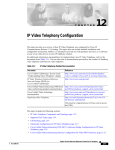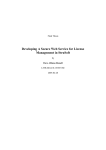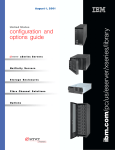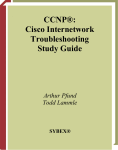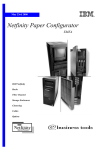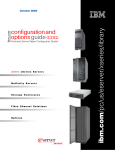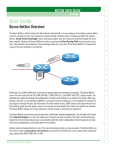Download Cisco IP Phones
Transcript
chpt_01.fm Page 4 Tuesday, February 4, 2003 3:07 PM Upon completing this chapter you will be able to do the following tasks: • Given a four-layer box, label each box with the correct layer from the Cisco Architecture for Voice, Video, and Integrated Data (Cisco AVVID) architecture. • Given some pictures or definitions, identify the core Cisco IP Telephony (CIPT) components. • Given a list of tasks performed by the Cisco CallManager, identify and describe the primary tasks performed by Cisco CallManager. • Given photos of the different Cisco IP Phones, identify the model number of those phones. chpt_01.fm Page 5 Tuesday, February 4, 2003 3:07 PM CHAPTER 1 Introduction to Cisco IP Telephony (CIPT) Components This chapter discusses the Cisco IP Telephony (CIPT) components. CIPT is part of Cisco’s Architecture for Voice, Video and Integrated Data (Cisco AVVID). The Cisco AVVID focus is for a converged network that runs voice, video, and data. CIPT, centered on Cisco CallManager, converges voice and data networks. This chapter introduces Cisco AVVID and the core components of CIPT. The following topics are discussed in this chapter: • • • • • • Abbreviations Audience Prerequisites Sources of Information Cisco AVVID CIPT Components Abbreviations This section defines the abbreviations used in this chapter. For more information about terms and abbreviations used in this chapter refer to the IP Telephony Network Glossary at the following URL: www.cisco.com/univercd/cc/td/doc/product/voice/evbugl4.htm Table 1-1 provides the abbreviations and complete term for abbreviations used frequently in this chapter. chpt_01.fm Page 6 Tuesday, February 4, 2003 3:07 PM 6 Chapter 1: Introduction to Cisco IP Telephony (CIPT) Components Table 1-1 Abbreviation with Definition Abbreviations Definitions AA Auto Attendant API application programming interface ATM Asynchronous Transfer Mode AVVID Architecture for Voice, Video, and Integrated Data CIPT Cisco IP Telephony CRA Customer Response Applications DHCP Dynamic Host Configuration Protocol DSP digital signal processor DTMF dual tone multifrequency GW gateway HTML Hypertext Markup Language ICD Integrated Contact Distribution IOS Internetworking Operating System IPCC IP Contact Center IVR Interactive Voice Response JTAPI Java TAPI MCS Media Convergence Server MGCP Media Gateway Control Protocol OSI Open System Interconnection PA Personal Assistant PBX private branch exchange POP Post Office Protocol PPS Phone Productivity Services PSTN public switched telephone network PTT Post, Telephone, and Telegraph QoS Quality of Service SMDI simple message desktop interface SMTP Simple Mail Transfer Protocol TAPI Telephony Application Programming Interface TDM time-division multiplexing chpt_01.fm Page 7 Tuesday, February 4, 2003 3:07 PM Prerequisite Knowledge Table 1-1 7 Abbreviation with Definition (Continued) Abbreviations Definitions UM Unified Messaging UPS uninterruptible power supply UTP unshielded twisted pair VG200 Voice Gateway 200 VM voice messaging VoIP Voice over IP WAN wide-area network Audience This book is written for the individual responsible for installing, configuring, and maintaining a CIPT solution. CIPT spans a variety of disciplines, so you may have a strong networking background or a strong telephony background or a strong applications background or a strong server background. Regardless of your background, this book will try to address all aspects of CIPT. Will the book cover every concept in which you are interested to the depth that you would like? Probably not, but if more information is needed, you can search on www.cisco.com to find numerous links that will assist in your learning. Because CIPT spans a variety of disciplines, your skills, with the help of this book, will enable you to become a valuable asset to your company. It is very rare to find an individual that is knowledgeable of all the disciplines in a CIPT network. By reading through this book, you will become one of the rare individuals with knowledge of all four disciplines. Prerequisite Knowledge To fully benefit from reading this book, you should already possess certain skills. These skills can be gained from completing the Internetworking Technology Multimedia (ITM) CD-ROM or through work experience. You should have the following prerequisite experience: • • Cisco Certified Networking Associate (CCNA). • Building a switched LAN environment. Gained from the Cisco course, Building Cisco Multilayer Switched Networks (BCMSN). • Work experience and knowledge of Windows 2000 Server and SQL server. Building VoIP networks. Gained from the Cisco course, Cisco Voice Over Frame Relay, ATM, and IP v2.0 (CVOICE). chpt_01.fm Page 8 Tuesday, February 4, 2003 3:07 PM 8 Chapter 1: Introduction to Cisco IP Telephony (CIPT) Components For more practice to help reinforce the concepts discussed in this book, it will benefit you to have access to Cisco CallManager, Cisco IP Phones, and other equipment discussed in this book. Sources of Information Most of the information presented in this book can be found on the Cisco Systems Web site or on CD-ROM. These supporting materials are available in HTML format and as manuals and release notes. To learn more about the subjects covered in this book, feel free to access the following sources of information: • • • Cisco Documentation CD-ROM or www.cisco.com. ITM CD-ROM or www.cisco.com. Cisco IOS 12.0 Configuration Guide and Command Reference Guide: www.cisco.com/univercd/cc/td/doc/product/software/ios120/12cgcr/ • • Voice over IP Fundamentals, by Jonathan Davidson, CCIE. ISBN: 1-57870-168-6. • • Routing TCP/IP, Volume I, by Jeff Doyle, CCIE. ISBN: 1-57870-041-8. • • Integrating Voice and Data Networks, by Scott Keagy, CCIE. ISBN: 1-57870-196-1 • Cisco CallManager Fundamentals: A Cisco AVVID Solution, by John Alexander, Chris Pearce, Anne Smith, and Delon Whetten. ISBN: 1-58705-008-0. Internetworking Technologies Handbook, Third Edition, by Cisco Systems, Inc. ISBN: 1-58705-001-3. Cisco IP Telephony Solution Guide: www.cisco.com/warp/public/788/solution_guide/. Cisco IP Telephony Network Design Guides: www.cisco.com/univercd/cc/td/doc/product/voice/ip_tele/index.htm. All online documents can all be found at www.cisco.com. Cisco AVVID Why is there a movement to converged networks and why use IP? As shown in Figure 1-1, the Web, or Internet/intranet, has the most successful application architecture around. Application servers, either private or public, reside on the Internet or intranet serving applications, such as HTML, Java, RealAudio, MP3, POP/SMTP mail, and others. chpt_01.fm Page 9 Tuesday, February 4, 2003 3:07 PM Cisco AVVID Figure 1-1 9 The Most Successful Application Architecture Application (private servers) IP HTML Java (Intranet/Internet) Browser (client) RealAudio MP3 POP/SMTP mail Application (commercial service) Today’s multiple communication networks are entirely separate, each serving a specific application. The traditional PSTN (TDM) network serves the voice application; the Internet and intranets serve data communications; and multiple private and public H.320 networks exist for the purpose of video conferencing. Often, everyday business requirements force these networks to interoperate. (Have you ever been on a videoconference for video while using the PSTN and a Polycom for audio or used NetMeeting?) As a result, deploying multiservice (data, voice, and video) applications, such as UM or Web-based customer contact centers, is a daunting task because it requires expensive and complex links between proprietary systems (such as PBXs) and standardsbased data networks. Cisco AVVID is a significant milestone in the evolution of IP networking for the enterprise. It enables customers to move from maintaining a separate data network and a closed, proprietary voice PBX system to maintaining one open and standards-based converged network for all their data, voice, and video needs. Also, Cisco AVVID provides customers a path to the New World today, removing their dependency on Old World proprietary suppliers who have yet to migrate from traditional PBXs. Figure 1-2 displays the classic four layers of Cisco AVVID in the infrastructure layer, the Call Processing layer denoting Cisco CallManager, the Application layer where Contact Center and UM reside, and the Client layer where end devices such as Cisco IP Phones reside. The key concepts are as follows: • The Client layer brings the applications to the user regardless if the end device is a Cisco IP Phone, a PC using Cisco IP SoftPhone, or a PC delivering UM. • Applications are physically independent from call processing and the physical voice processing infrastructure; they may reside anywhere within your network. chpt_01.fm Page 10 Tuesday, February 4, 2003 3:07 PM 10 Chapter 1: Introduction to Cisco IP Telephony (CIPT) Components Figure 1-2 • Call processing is physically independent from the infrastructure. Thus, you can have a Cisco CallManager in Chicago processing call control for a bearer channel in San Francisco. • The infrastructure can support multiple client types, hard phones (physical devices such as Cisco IP Phones), soft phones (virtual devices such as Cisco IP SoftPhone), and video phones. Cisco AVVID Layers Video SoftPhone Applications TAPI, JTAPI, SMDI IP Phone PC V Cisco Unity Cisco IPCC Call Admission, Call Routing CallManager Directory Open Manageable Call Processing Adaptive Distributed Clients Infrastructure Cisco IOS Network Services Gateway Router Switch Applications IP-based voice and video applications increase competitive advantages by improving productivity and enabling exceptional customer care. The following are some of the voice and video applications currently available: • Cisco Personal Assistant (PA) is an IP-based telephony application that delivers personalization, ease of use, and enhances productivity in the workplace by streamlining voice communications with personal call rules and speech recognition. As an integral part of the Personal Productivity Suite, PA interoperates with Cisco CallManager and scales to meet the present and future needs of enterprises. Users browse voice mail, dial by name, and conference from any telephone using verbal commands instead of the telephone keypad. The administration interface enables users to forward and screen calls in advance or in real time. • Cisco Integrated Contact Distribution (ICD) provides automated voice call distribution within the enterprise and supports custom contact interaction management. chpt_01.fm Page 11 Tuesday, February 4, 2003 3:07 PM Cisco AVVID 11 • Cisco IP PPS is a suite of personal productivity applications for Cisco IP Phones that provides services that allow users to check e-mail, voice mail, calendar, and personal contact information using the large LCD display and interactive soft keys on the Cisco IP Phone. • Cisco Unity messaging application, a key component of the CIPT solution, provides VM functionality to enterprise communications. Cisco Unity is also able to deliver a unified communications solution for the CIPT solution. A unified communications solution provides access to voice, e-mail, and fax messaging from a single source using various access points. • Cisco IP Contact Center (IPCC) combines CIPT and contact center solutions. The IPCC delivers an integrated suite of proven products that enable agents using Cisco IP Phones to receive both TDM and VoIP calls. Because the IPCC was intended for integration with legacy call center platforms and networks, it provides a migration path to IP-based customer contact while taking advantage of previous technology investments. • IP/TV and IP/Video Conferencing products enable distance learning and workgroup collaboration. • An IP-powered Interactive Voice Response (IVR) solution, Cisco IP IVR combined with Cisco IP AA provides an open, extensible, and feature-rich foundation for delivering IVR solutions over an IP network. • Cisco WebAttendant replaces the traditional PBX manual attendant console; WebAttendant provides a flexible and scalable IP-based solution. • Cisco IP SoftPhone provides transportable communication capabilities that increase personal efficiency and promote collaboration. For more information about the Cisco AVVID application layer go to www.cisco.com/warp/public/779/largeent/avvid/products/iptel_apps.html. Call Processing Cisco CallManager is a software-based call processing application that is the foundation of an end-to-end VoIP network solution. Cisco CallManager can be distributed and clustered over an IP network allowing it to scale to 10,000 users with triple call processing redundancy per device. Multiple clusters can be tied together to enable expansion of up to hundreds of thousands of users. Cisco CallManager provides signaling and call control services to Cisco integrated applications as well as third-party applications. Cisco CallManager is central to the distributed architecture of any converged network. For more information about the Cisco AVVID call processing layer go to www.cisco.com/warp/public/779/largeent/avvid/products/call_process.html. chpt_01.fm Page 12 Tuesday, February 4, 2003 3:07 PM 12 Chapter 1: Introduction to Cisco IP Telephony (CIPT) Components Infrastructure The following is a breakdown of components of the infrastructure layer of Cisco AVVID: • Cisco Certified Servers—High-availability server platforms for Cisco AVVID from Compaq (such as the ProLiant DL320 and DL380), the MCS-7800 series (such as the MCS-7825 and 7835), and IBM (such as the xSeries 330 and 340). The Cisco certified server platforms are an integral part of a complete, scalable architecture for a new generation of high-quality IP voice solutions that run on enterprise data networks. The servers deliver the high performance and availability demanded by today’s enterprise networks and represent a turnkey solution that is easy to deploy and highly cost effective. • Switches—The entire line of Catalyst chassis and stackable switches support a variety of voice features, including inline power for Cisco IP Phones and VoIP gateway cards. Some examples include the Cisco Catalyst 6000, Cisco Catalyst 4000, Cisco Catalyst 3500, and Cisco Catalyst 2900. • Integrated IP telephony solution—An ideal communications solution for branch office and mid-market businesses wanting to deploy New World applications. Some examples are the Cisco Integrated Communications System 7750 (ICS-7750) and the Cisco Catalyst 4200 product line. • Voice gateways—Cisco voice gateways are a reliable, manageable way to connect IP telephony systems to existing switches or analog devices and to provide trunk capabilities that can scale to accommodate IP telephony networks for small, medium, and large offices. The Cisco voice gateway products extend enterprise-class versatility, integration, and cost-savings to remote sites and branch offices by enabling toll-bypass. Some examples are the Cisco Catalyst 6000 T/E1 module, Cisco 2600, Cisco 3600, Cisco AS5300, and Cisco Catalyst 4000. For more information about the Cisco AVVID infrastructure layer go to www.cisco.com/warp/public/779/largeent/avvid/products/infrastructure.html. Clients Cisco is now delivering second-generation IP-enabled communication devices: • Cisco IP Phone 7960—The Cisco IP Phone 7960 is a second generation full-featured, IP telephone primarily for executives and managers providing six line or speed dial buttons and many more features. • Cisco IP Phone 7940—The Cisco IP Phone is similar to the 7960 with two lines or speed dial buttons. • Cisco IP Phone 7910—The Cisco IP Phone 7910 is a second generation, basicfeature phone mainly for use in lobby areas, break rooms, and hallways. This phone features a single line without the large LCD found on the 7960 and 7940 models. chpt_01.fm Page 13 Tuesday, February 4, 2003 3:07 PM VoIP Flavors NOTE 13 • Cisco IP Conference Station 7935—The Conference Station 7935 couples state-ofthe-art conference room speakerphone technologies from Polycom with the Cisco award-winning AVVID technologies. • Cisco IP SoftPhone—The Cisco IP SoftPhone is a PC-based phone that shares characteristics with the Cisco IP Phone 7960. The SoftPhone is a virtual device, allowing the user to effectively bring his or her phone along (on a laptop) during travel and still have the same phone functionality available as if the user were still at his or her desk in the office. • Cisco IP Phone 30VIP—The Cisco IP Phone 30VIP is a first-generation (legacy) Cisco IP Phone (replaced by the 7960). It provides 30 programmable line or feature buttons, high-quality speakerphone/microphone, mute, and a two-line LCD for call status and ID. • Cisco IP Phone 12SP+—The Cisco IP Phone 12SP+ is a first-generation (legacy) Cisoc IP Phone (replaced by the 7910). It provides 12 programmable line or feature buttons, high-quality speakerphone, and a two-line LCD for call status and ID. Although the Cisco IP Phone 30VIP and 12 SP+ can be found in some networks, these models can no longer be purchased from Cisco. For more information about the client layer of Cisco AVVID, go to www.cisco.com/warp/public/779/largeent/avvid/products/clients.html VoIP Flavors There are many flavors of VoIP. Figure 1-3 shows how VoIP was first introduced. Over time, the Internet (and data networking technology in general) has been slowly subsuming these other traffic types. (Desktop conferencing is becoming more ubiquitous, and the mainframe has evolved from being a separate network to being a server on the IP data network.) This convergence has recently—within the past four years—begun absorbing voice and video as applications into the data network. Several large PTT carriers have been using packet switching or Voice over ATM as their backbone technology for years, and enterprise customers have accepted virtual trunking or connecting their disparate PBXs via their widearea data network to avoid long distance toll charges. Toll-bypass configuration details are discussed in the Cisco Voice over Frame Relay, ATM, and IP (CVOICE) course. Some examples of Internet telephony solutions include NetMeeting-to-NetMeeting and NetMeeting-to-phone via the Internet. chpt_01.fm Page 14 Tuesday, February 4, 2003 3:07 PM 14 Chapter 1: Introduction to Cisco IP Telephony (CIPT) Components Figure 1-3 The Many Flavors of VoIP PBX PBX IP WAN V Router/GW V Router/GW Toll Bypass Cisco Cisco CallManager CallManager V Router/GW IP WAN V Router/GW End-to-End IP Telephony with Application Enablement VoIP With the introduction of Cisco CallManager, companies can incorporate the toll-bypass solution and provide an end-to-end solution using VoIP. Cisco CallManager provides call processing for Cisco IP Phones and signaling support for end-to-end VoIP. This book discusses the end-to-end solution centered on Cisco CallManager. The end-to-end solution is built using the following three levels: • • • NOTE Applications Scalable call processing QoS-enabled infrastructure There are four layers of Cisco AVVID, however, this section focuses on the three mentioned in the preceding list. The fourth, Clients, will be discussed in the “CIPT Components” section in this chapter. As in building a house, you want to start with the foundation. An infrastructure without QoS will not provide a good VoIP experience for you or the end user. End users expect quality voice and a reliability of five-nines (0.99999) from their voice applications. A QoS-enabled infrastructure is the first step to building an end-to-end VoIP solution. chpt_01.fm Page 15 Tuesday, February 4, 2003 3:07 PM VoIP Flavors 15 Scalable call processing can be compared with the electricity delivered to all rooms of a house and the circuit box being able to supply electricity to more rooms when you build extensions to the home. Each time you walk into a room and turn on a light, you want the electrical current available to flow to that room and illuminate the lights. Cisco CallManager provides scalability using a clustered environment and available call processing. When the user makes a call, Cisco CallManager is available to handle the call processing for that call. Applications are like the electrical appliances we plug into electrical outlets in our home. A variety of appliances (television, radio, refrigerator, computer, microwave, and so on) are plugged in, all working together and providing services that we need. Applications in an end-to-end VoIP solution can provide services such as directory services to the phone, Web content, music, IVR, and much more. The New World, open packet telephony architecture as shown in Figure 1-4 provides a standards-based packet infrastructure, open Call Control layer, and an open service Application layer. The TDM or circuit-switched technology can be aligned with any of the three layers in an end-to-end VoIP solution. Open Packet Telephony Architecture Open Service Application layer Open/Standard interface TDM/ Circuit Switch Digital Trunk Subsystem Call Control Connection Control Network Line Concentration Switching Figure 1-4 Features Common Channel Open Call Control layer Signaling Complex Administration Maintenance Billing Open/Standard interface Standards-based IP Packet Infrastructure V layer Cisco IP Phones Infrastructure GWs The standards-based infrastructure provides for client, gateway, and switching devices to operate in this converged network. Cisco CallManager works in the Call Control layer, providing call processing and signaling for clients and gateways. The Application layer is open, and innovative application services are rapidly being developed. Voice mail (VM), IVR, Audio Attendant (AA), and more applications are provided for in this layer. chpt_01.fm Page 16 Tuesday, February 4, 2003 3:07 PM 16 Chapter 1: Introduction to Cisco IP Telephony (CIPT) Components CIPT Components The CIPT network is a part of Cisco AVVID. The first “V” in Cisco AVVID designates the CIPT solution. Figure 1-5 shows a simple topology that highlights the CIPT components. Figure 1-5 CIPT Components Voice messaging/ applications Call processing DSP resources for conferencing VM/UM Cisco CallManager Router/GW IP WAN WAN IP DSP V PSTN PSTN Cisco IP Phones/endpoints PSTN GW/router QoS-enabled WAN infrastructure The following CIPT components are discussed in this section: • Cisco CallManager—The software-based IP call processing engine of the CIPT network. Cisco CallManager extends enterprise telephony features and functions to packet telephony network devices such as Cisco IP Phones, media processing devices, VoIP gateways, and multimedia applications. • Cisco IP Phones—The IP-based, full-featured telephones. Cisco IP Phones provide standard telephone functionality: call connection, hold, transfer, call park, conferencing, and more. Two of the available Cisco IP Phone models (7960 and 7940) enable you to deploy custom services that extend the phone’s functionality beyond the traditional realm. With Cisco IP Phone services, you can extend the phone’s purpose to more than a simple voice communication device. • Gateways—The device that enables Cisco CallManager to communicate with non-IP telecommunications devices. Feature interoperability with versions of Cisco CallManager make these products perfect gateways for the PBX and PSTN for IP telephony, enabling features like call transfer, hold, and conferencing. — Digital Gateways—The Voice T1 and Services Module allows larger enterprises to connect the PSTN and legacy PBXs directly into the campus multiservice network. chpt_01.fm Page 17 Tuesday, February 4, 2003 3:07 PM CIPT Components 17 — Analog Gateways—The Analog Gateway Module allows enterprises to connect legacy analog telephony equipment such as phones, speaker phones, and faxes. NOTE • Inline Power Modules—The devices that enable inline power and simplify IP telephony deployment in the enterprise wiring closet and branch office. The Inline Power 10/100 Ethernet switching modules enable new Fast Ethernet features that are necessary for convergence in the wiring closet, such as phone discovery and auxiliary or voice VLANs. • DSP Resources—Transcoding and conferencing are services for the multiservice network. Transcoding enables a full voice compression solution by offering transcoding services to endpoints not capable of supporting compressed voice or a different encoding type to the remote end. Cisco CallManager directs the media stream to one of several available DSP resources that bridge the media streams together while converting one codec to another dynamically. • Applications—The various software that extends the functionality of the CIPT solution. Applications include VM, PA, IVR, IPCC, IP AA, and more. Because there are many products that integrate with CIPT, the following URL lists all the products and part numbers to order from Cisco Systems, Inc.: www.cisco.com/univercd/cc/td/doc/pcat/iptl__e1.htm#CHDDGAGB Cisco CallManager Cisco CallManager is the core call processing component of the CIPT solution. Cisco CallManager extends enterprise telephony features and functions to packet telephony network devices such as Cisco IP Phones, media processing devices, VoIP gateways, and multimedia applications. Additional data, voice, and video services, such as UM, multimedia conferencing, collaborative contact centers, and interactive multimedia response systems interact with the IP telephony solution through Cisco CallManager’s open TAPI. Cisco CallManager is installed on the Cisco MCS and the following certified server platforms: Compaq ProLiant DL320 and DL380 servers and IBM xSeries 330 and 340 servers. Cisco CallManager includes a suite of integrated voice applications that perform voice conferencing and manual attendant console functions. The salient benefit of all these voice applications is that special-purpose voice processing hardware is not required. Supplementary and enhanced services such as hold, transfer, forward, conference, multiple-line appearances, automatic route selection, speed dial, last-number redial, and other features are extended to Cisco IP Phones and gateways. Because Cisco CallManager is a software application, chpt_01.fm Page 18 Tuesday, February 4, 2003 3:07 PM 18 Chapter 1: Introduction to Cisco IP Telephony (CIPT) Components enhancing its capabilities in production environments is a matter of upgrading software on the server platform, thereby avoiding expensive hardware upgrade costs. Further, Cisco CallManager and all phones, gateways, and applications can be distributed across an IP network, providing a distributed, virtual telephony network. The benefit of this architecture is improved system availability and scalability. Call admission control ensures that voice QoS is maintained across constricted WAN links and automatically diverts calls to alternate PSTN routes when WAN bandwidth is not available. The MCS 7800 series (MCS-7800), Compaq Proliant DL320 and DL380, and IBM xSeries 330 and 340 are the supported hardware platforms for Cisco CallManager that provide for scalable hardware architecture. MCS 7800 Series The Cisco MCSs are powerful platforms for Cisco AVVID. The Cisco MCSs are an integral part of a complete, scalable architecture for a new generation of high-quality IP voice solutions that run on enterprise data networks. The MCS delivers the high performance and availability demanded by today’s enterprise networks and represents a turnkey solution that is easy to deploy and highly cost effective. NOTE No third-party software applications should run on an MCS series platform. The sections that follow provide more detail about the MCS-7825-800 and MCS-7835-1000. Cisco MCS 7825-800 The Cisco MCS 7825-800 (MCS-7825-800) is only one rack unit (1U) high and is the most space-efficient member of the MCS-7800 Series Server Family. You can configure the MCS-7825-800 to ship with Cisco CallManager release 3.1 or Cisco IP IVR, either of which can be loaded via a fast-running installation script to make the deployment of IP telephony simple and cost effective. Cisco MCS 7835-1000 The Cisco MCS 7835-1000 (MCS-7835-1000) is only 3U high, the MCS-7835-1000 packs tremendous power in a low-profile chassis that minimizes rack space. The MCS-7835-1000 runs a variety of Cisco AVVID applications, such as Cisco CallManager and the Cisco IP IVR solution. chpt_01.fm Page 19 Tuesday, February 4, 2003 3:07 PM CIPT Components 19 Compaq ProLiant DL320 and DL380 Servers Software-only versions of CallManager and other CIPT applications are available for customers providing their own Cisco-approved server configuration of the Compaq ProLiant DL320 or DL380 server. Any deviation from the approved configuration will result in a non-supported system. The installation will not complete if the exact configuration is not followed. Customers can order the servers from their Compaq reseller or distributor or from the Compaq Web site at www.directplus.compaq.com (select Specials and Promotions and then enter Affiliate Pass code 4080). The sections that follow describe the approved configurations for the Compaq ProLiant DL320 and DL380. Compaq DL320 The DL320 is a high-performance server platform designed for today’s IP telephony applications. When clustered properly, this server can support 2000 users. The required processor is an Intel Pentium III 800MHz processor. No specific memory configuration is required as long as 512 MB of memory is achieved. Table 1-2 describes the Compaq DL320 parts. Table 1-2 Compaq DL320 Parts Qty Compaq Part Number Description 1 201501-001 ProLiant DL320-128 Model-1 ATA 1 212697-B21 20 GB ATA/100 7200 RPM Drive 1" 1 128278-B21 256 MB Registered 133MHz SDRAM DIMM 1 128277-B21 128 MB Registered 133MHz SDRAM DIMM 1 212691-B21 CD-ROM/Diskette Assembly 1 174574-B21 Third-Party Cabinet Rack Kit (Optional) Compaq DL380 The DL380 is a robust server solution designed for CIPT software applications. When clustered properly, this server can support 10,000 users. The required processor is an Intel Pentium III 1GHz processor. No specific memory configuration is required as long as 1GB of memory is achieved. Table 1-3 describes the Compaq DL380 parts. chpt_01.fm Page 20 Tuesday, February 4, 2003 3:07 PM 20 Chapter 1: Introduction to Cisco IP Telephony (CIPT) Components Table 1-3 Compaq DL380 Parts Qty Compaq Part Number Description 1 193706-001 ProLiant DL380R01 P1000/133-128 2 142673-B22 18.2 GB Pluggable Wide Ultra SCSI3 Universal 10 KB Drive 1 128279-B21 512 MB Registered 133MHz SDRAM DIMM 1 128278-B21 256 MB Registered 133MHz SDRAM DIMM 1 128277-B21 128 MB Registered 133MHz SDRAM DIMM 1 143397-001 DL380 275 Watt HP RPS Module 1 295513-B22 12/24 GB DAT Drive (DDS-3)-Opal (Optional) For more information about the Compaq servers go to www.cisco.com/warp/public/779/largeent/avvid/products/cmpq_srvrs.html IBM Servers IBM provides a Cisco server solution for Cisco CallManager and other IP telephony applications as described in the sections that follow. IBM xSeries 330 and 340 Servers Software-only versions of CallManager and other IP telephony applications are available for customers providing their own Cisco-approved server configuration of the IBM xSeries 330 and 340 servers. Any deviation from the approved configuration will result in a nonsupported system. The installation will not complete if the exact configuration is not followed. Customers can order the servers from their IBM reseller or distributor or directly from IBM. Approved Configurations for the IBM xSeries 330 Servers The xSeries 330 is a high-performance server platform designed for today’s IP telephony applications. When clustered properly, this server can support 2000 users. The minimum required processor is an Intel Pentium III 800MHz processor. No specific memory configuration is required as long as 512 MB of memory is achieved. Table 1-4 shows the xSeries 330 parts. chpt_01.fm Page 21 Tuesday, February 4, 2003 3:07 PM CIPT Components Table 1-4 21 IBM xSeries 330 Parts Qty IBM Part Number Description 1 865411Y X330 800 256 256/Open 24X 1 37L7205 18.2 Ultra 160 SCI HS SL HD 1 33L3144 256MB ECC SDRAM RDIMM Memory 1 06P4792 xSeries Cable Chain Tech Kit Other supported processors are listed below. Replace part number 865411Y. 1 865431Y X330 866 256 256/Open 24X 1 865441Y X330 933 256 256/Open 24X 1 865451Y X330 1000 256 256/Open 24X Approved Configurations for the IBM xSeries 340 Servers The xSeries 340 is a robust server solution designed for CIPT software applications. When clustered properly, this sever can support 10,000 users. The required processor is an Intel Pentium III 1GHz processor. No specific memory configuration is required as long as 1 GB of memory is achieved. Table 1-5 shows the xSeries 340 parts. Table 1-5 IBM xSeries 340 Parts Qty IBM Part Number Description 1 86566RY X340 1000 256 128/Open 24X 2 37L7205 18.2 Ultra 160 SCSI HS SL HD 1 33L3123 128 MB ECC SDRAM RDIMM Memory 1 33L3125 256 MB ECC SDRAM RDIMM Memory 1 33L3127 512 MB ECC SDRAM RDIMM Memory 1 37L6091 ServerRAID-4L Ultra 160 SCSI 1 37L6880 270W Redundant Power Supply 1 00N7991 20/40 GB DDS/4 4mm Internal Tape Drive (Optional) For more information about the IBM servers go to www.cisco.com/warp/public/779/largeent/avvid/products/ibm_srvrs.html. NOTE Cisco CallManager and other IP telephony applications ship on separate CD-ROMs and are designed for customers who want to provide their own server platform. More and more server platforms are being tested and certified; check with your local Cisco representative for the most current list of supported server platforms. chpt_01.fm Page 22 Tuesday, February 4, 2003 3:07 PM 22 Chapter 1: Introduction to Cisco IP Telephony (CIPT) Components Cisco IP Phones Cisco IP Phones provide the “end” in end-to-end VoIP networks. The Cisco IP Phone series is a standards-based communication appliance. The Cisco IP Phone series can interoperate with IP telephony systems based on the Skinny Client Control Protocol (Skinny protocol), SIP, and (in the future) MGCP with system-initiated software updates. This multiple protocol capability is an industry first and provides investment protection and migration capability. Learn more about adding and configuring Cisco IP Phones in Chapter 6, “Cisco IP Telephony Devices,” and 7, “Understanding and Using the Bulk Administration Tool (BAT).” Cisco IP Phone 7960 The Cisco IP Phone 7960 shown in Figure 1-6 is a second-generation, full-featured Cisco IP Phone primarily designed for executives and managers. It provides six line or speed dial buttons and four interactive soft keys located beneath the display that guide a user through call features and functions such as hold, transfer, call park, conference, and more. The 7960 also features a large pixel-based LCD that provides the date and time, calling party name, calling party number, digits dialed, and feature and line status. A speaker is provided for hands-free communication along with a headset button and a mute button that controls the speaker, handset, or headset microphones. Figure 1-6 Cisco IP Phone 7960 A cluster of buttons provide access to help (the i button), voice mail (the messages button), detailed configuration information, the ability to choose ringer sound, and more (the settings button), and access to standard and custom-configured directories (the directories button) and standard or customized phone services (the services button). You can learn more about creating customized directories or phone services in Chapter 5, “Cisco CallManager Administration Features and User Menus.” Cisco IP Phone 7940 The Cisco IP Phone 7940 shown in Figure 1-7 is a second-generation, full-featured Cisco IP Phone primarily designed for employees or individual contributors. It provides two line or speed dial buttons and four interactive soft keys located beneath the display that chpt_01.fm Page 23 Tuesday, February 4, 2003 3:07 PM CIPT Components 23 guide a user through call features and functions, such as hold, transfer, call park, conference, and more. Like the 7960, the 7940 features a large pixel-based LCD that provides features such as date and time, calling party name, calling party number, digits dialed, and feature and line status. A speaker is provided for hands-free communication along with a headset button and a mute button that controls speaker or handset or headset microphones. Figure 1-7 Cisco IP Phone 7940 A cluster of buttons provide access to help (the i button), voice mail (the messages button), detailed configuration information, the ability to choose ringer sound, and more (the settings button), and access to standard and custom-configured directories (the directories button) and standard and customized phone services (the services button). You can learn more about creating customized directories or services in Chapter 5. Cisco IP Conference Station 7935 The Cisco IP Conference Station 7935 shown in Figure 1-8 is a full-featured, IP-based, full-duplex, hands-free conference phone for use on desktops and offices and in small- to medium-sized conference rooms. This device easily attaches a Catalyst 10/100 Ethernet switch port with a simple RJ-45 connection. It features superior sound quality with a digitally tuned speaker and three microphones, allowing conference participants to move around while speaking or be situated around the Cisco 7935 device. In addition to the regular telephone keypad, the Cisco 7935 provides three soft keys and menu navigation keys that guide a user through call features and functions. The Cisco 7935 also features a pixel-based LCD providing the date and time, calling party name, calling party number, digits dialed, and feature and line status. chpt_01.fm Page 24 Tuesday, February 4, 2003 3:07 PM 24 Chapter 1: Introduction to Cisco IP Telephony (CIPT) Components Figure 1-8 Cisco IP Conference Station 7935 Cisco IP Phone 7914 Cisco IP Phone 7914 Expansion Module shown in Figure 1-9 extends the functionality of the Cisco IP Phone 7960 by providing 14 additional line or speed dial buttons. Figure 1-9 Cisco IP Phone 7914 The Cisco 7914 has an LCD to identify the function of the button and the line status. You can daisy chain up to two Cisco 7914 Expansion Modules to provide 28 additional line or speed dial buttons. The 7914 allows for an easier integration with Cisco WebAttendant. When the 7914 is added to a 7960, you will have total of 20 lines and speed dials. NOTE The 7914 cannot utilize inline power through the phone and must be powered by a wall jack. chpt_01.fm Page 25 Tuesday, February 4, 2003 3:07 PM CIPT Components 25 Cisco IP Phone 7910 and 7910+SW The Cisco 7910 and 7910+SW shown in Figure 1-10 are basic telephones primarily for common-use areas that require only basic features, such as lobbies, break rooms, and hallways. The Cisco 7910+SW includes a Cisco three-port switch making it suitable for worker applications where basic phone functionality and a co-located Ethernet device such as a PC are desirable. The third port is not visible to the user because the port is inside the phone. Figure 1-10 Cisco IP Phone 7910 and 7910+SW This single-line phone also provides four dedicated feature buttons: line, hold, transfer, and settings, located prominently under the display. A cluster of six configurable feature buttons is located above the volume buttons. The factory default configuration for the six buttons is messages (msgs), conference (conf), forward, speed dial (speed 1, speed 2), and redial. Using a custom button template you create, the buttons can be configured to perform other functions, such as call park and call pick up, as well as additional speed dials and other traditional telephone features. The 7910 provides a pixel-based, 2x24 character LCD, showing the date and time, calling party name, calling party number, and digits dialed, as well as call state indicators, a settings menu, and other information. No speakerphone capability is provided, but there is an on-hook dialing feature and call monitor mode. The phone also has a mute button for the handset and headset microphones. In addition, the phone has a rocker switch for controlling volume for ringer, handset, and call monitor. The phone supports a headset when you disconnect the handset and plug the headset into the jack formerly used by the handset. chpt_01.fm Page 26 Tuesday, February 4, 2003 3:07 PM 26 Chapter 1: Introduction to Cisco IP Telephony (CIPT) Components Cisco IP SoftPhone Cisco IP SoftPhone shown in Figure 1-11 is a Windows-based application for the PC. Used as a stand-alone endpoint or in conjunction with the Cisco IP Phone, it provides the following features: • Mobility—With Cisco IP SoftPhone running on a laptop, you can take your extension with you and receive calls wherever you are connected to the corporate network. Even dial-up connections while on the road can be used to check voice mail and place calls while online. • Directory Integration—Integration with LDAP3 directories enables you to quickly place or transfer calls by looking up people by name or e-mail address. Corporate and public directories as well as a personal address book are supported. • User Interface—Cisco IP SoftPhone has an intuitive user interface and context sensitive controls replace the keystroke combinations of legacy phones. Extensive use of drag-and-drop enables you to quickly place calls using VCards, directory entries, and text fields from most Windows programs. • Virtual Conference Room—With Cisco IP SoftPhone setting up conference calls is quick and intuitive. Participants can be invited by dragging and dropping directory entries onto the SoftPhone’s user interface to create a virtual conference room. Once a voice conference is established you can share applications running on your desktop with all participants by selecting them from a list or dragging associated documents onto the virtual conference room. Figure 1-11 Cisco IP SoftPhone chpt_01.fm Page 27 Tuesday, February 4, 2003 3:07 PM CIPT Components NOTE 27 Technically Cisco IP SoftPhone is a CIPT application; however, most users think of Cisco IP SoftPhone as a phone. Gateways There are over 20 Cisco voice gateway candidates to choose from. Gateways range from specialized, entry-level, stand-alone voice gateways to the high-end, feature-rich integrated router and Catalyst gateways. You should choose a gateway by combining common or core requirements with site- and implementation-specific features. The three common or core requirements for a CIPT gateway are • • • DTMF relay capabilities Support for supplementary services The capability to handle clustered CallManagers Any gateway selected for a large campus deployment should have the capability to support these features. Additionally, every CIPT implementation will have its own site-specific or implementation-specific feature requirements. Each of the gateways uses one of the supported protocols. The first protocol is the Skinny Gateway Control Protocol (SGCP or simply Skinny gateway). Skinny gateways are a series of digital gateways that include the DT-24+ and the DE-30+ (these are legacy gateways and, as such, are not shown in Table 1-6). The next gateway protocol is traditional H.323. Cisco IOS integrated router gateways use H.323 to communicate with Cisco CallManager. The final gateway protocol used in Cisco gateways is MGCP. Cisco CallManager uses MGCP to control the VG200 analog gateway, the 2600- and 3600-series gateways, Catalyst 4224, Catalyst 4000 Access Gateway Module, DT-24+, DE30+, WS-X6608x1, and WS-X6624-FXS Catalyst Voice Module. Each of the protocols used by these gateways follows a slightly different methodology to provide support for the core gateway features. Adding and configuring gateways is covered in Chapter 6, “Cisco IP Telephony Devices.” Table 1-6 lists the gateways supported in a CIPT network. chpt_01.fm Page 28 Tuesday, February 4, 2003 3:07 PM 28 Chapter 1: Introduction to Cisco IP Telephony (CIPT) Components Table 1-6 Gateways for a CIPT Network Skinny Gateway Protocol Gateway MGCP H.323 VG200 Yes, for FXS/FSO Yes,with Cisco IOS Software 12.1(5)XM1, the VG-200 uses H.323 to support a wider range of digital and analog interfaces No DT-24+ Yes with Cisco CallManager release 3.1 No Yes 827 No Yes for FXS No 1750 No Yes No 3810 V3 Cisco IOS Software 12.1(3)T and Cisco CallManager release 3.0(5) Yes No 2600 Cisco IOS Software 12.1(3)T and Cisco CallManager release 3.0(5) Yes No Yes No Yes No Analog Interfaces only no E&M T1 CAS 12.1(5)XM & 12.2.1T Q.931 PRI Backhaul 12.2.2T** 3600 Cisco IOS Software 12.1(3)T and Cisco CallManager release 3.0(5) Analog Interfaces only no E&M T1 CAS 12.1(5)XM & 12.2.1T Q.931 PRI Backhaul 12.2.2T** 7200 Cisco IOS Software 12.2.(1)T*** chpt_01.fm Page 29 Tuesday, February 4, 2003 3:07 PM CIPT Components Table 1-6 29 Gateways for a CIPT Network (Continued) Skinny Gateway Protocol Gateway MGCP H.323 7500 Undecided Yes (Cisco IOS Software 12.1.5) No 5300* Yes (Cisco IOS Software 12.1(1)T Yes No Catalyst 4000 WS-X4604-GWY Gateway Module Cisco CallManager release 3.1 Yes, for PSTN interfaces Yes, for conferencing and MTP/ transcoding services Catalyst 6000 WS-X6608-x1 Gateway Module & FXS Module WS-X6624 In Cisco CallManager release 3.1: No Yes, for FXS module and T1/E1 prior to Cisco CallManager release 3.1 Yes No T1/E1 module supporting PRI and CAS FXS module Catalyst 4224 Projected for Cisco CallManager release 3.1 ∗ While the 5300 supports MGCP, it is as a trunk gateway module using SS7 signaling, which is not supported in CallManager ** Cisco IOS Software Release 12.2.2T PRI Backhaul support for 26xx/36xx uses RUDP and is not compatible with Cisco CallManager. PRI Backhaul with Cisco CallManager release 3.1 as the Call Agent is scheduled for Cisco IOS Software Release 12.2.4T and uses TCP as the transport. *** Not supported in Cisco CallManager Also note prior to any deployment consideration, it would be prudent to check the IOS Release Notes to confirm feature or interface support. For more information about choosing a gateway, read “Choosing a Voice-over-IP Gateway—A 3.0 Gateway Solution Guide” at www.cisco.com/warp/public/cc/pd/ga/prodlit/gatwy_wp.htm Inline Power Switches The family of inline power switches extends the CIPT networking capabilities of the Catalyst backbone to the enterprise wiring closet and branch office. Many of the new Fast Ethernet modules support a feature called inline power, which is 48-volt DC power provided over standard Category 5 or higher UTP cable up to 100 meters. The inline power Fast Ethernet module enables the modular wiring closet infrastructure to provide centralized power for CIPT networks. chpt_01.fm Page 30 Tuesday, February 4, 2003 3:07 PM 30 Chapter 1: Introduction to Cisco IP Telephony (CIPT) Components Today there are two different implementations of inline powered Ethernet ports in Cisco Catalyst switching products. Each of these mechanisms allows Cisco Power Sourcing Equipment (PSE) to discover a phone and supply it operating power. Chapter 9, “LAN Infrastructure for Cisco IP Telephony,” discusses more about Cisco IP Phone discovery. The inline power modules prepare the network infrastructure for IP-based converged business applications that provide seamless communication and collaboration between branch and corporate sites. Not only do some of these switches provide inline power, some support single port multiple VLANs (voice and data subnets). The Inline Power 10/100BaseT Ethernet switching module supports up to 48 ports per module (RJ-45 interfaces). Along with phone discovery, these modules support autosensing/auto-negotiation to determine the speed and duplex mode of the attached device. The Catalyst 4003 uses the Catalyst Inline Power Patch Panel to provide inline power. The Catalyst 4006, with support for up to 240 multiservice ports, directly provides inline power. To support the new demand for phone power on the Catalyst 4006, Cisco has developed a new auxiliary DC power shelf that supplies the Catalyst 4006 with the 48 volts needed for inline power. Catalyst 6000 Cisco is using the Catalyst 6000 family to lead its customers to campus convergence. The first product features to be introduced are Fast Ethernet enhancements delivered by the new 48-port Inline Power 10/100BaseT Ethernet Switching Module. Instead of using wall power, terminal devices such as Cisco IP Phones use power provided from the Catalyst 6000 switch. This capability gives the network administrator centralized power control, which translates into greater network availability. By deploying the Catalyst 6000 family of switches with UPS systems in secured wiring closets, network administrators can ensure that building power outages will not affect network telephony connections. Catalyst 4224 The Catalyst 4224 can provide 48-volt DC power over standard Category 5 or higher UTP cable. Instead of requiring wall power at every desktop, terminal devices, such as Cisco IP Phones, use power supplied by the Catalyst 4224. With the Phone Discovery feature, the Catalyst 4224 automatically detects the presence of a Cisco IP Phone and supplies inline power. By deploying Catalyst 4224 switches with UPS systems, network administrators can ensure that power outages do not affect a branch office’s telephony connections. Catalyst 3524 The Catalyst 3524-PWR XL switch has 24 10/100 switched ports with integrated inline power and two Gigabit Interface Converter (GBIC)-based Gigabit Ethernet ports. Integrated chpt_01.fm Page 31 Tuesday, February 4, 2003 3:07 PM CIPT Components 31 inline power provides DC current to devices that can accept power over traditional UTP cabling (for example, the Cisco 79xx family of Cisco IP Phones or Cisco Aironet wireless access points). The dual GBIC-based Gigabit Ethernet implementation provides tremendous deployment flexibility, enabling you to implement one type of stacking and uplink configuration today while preserving the option to migrate that configuration in the future. Patch Panel The Catalyst Inline Power Patch Panel enables inline power for Cisco multiservice-enabled Catalyst switches that do not have inline power blades available within their product line. This capability gives the network administrator centralized power control, which translates into greater network availability. By deploying Catalyst gear with UPS systems in secured wiring closets, network administrators can ensure that building power outages will not affect network telephony connections. DSPs DSPs in a CIPT solution provide a means for transcoding between different codecs (for example, G.711, G.723, and G.729), converting TDM to packet, and conferencing resources. The following products have DSP resources that support transcoding, conferencing, and/or converting TDM to packet: NOTE • • • Catalyst 4000 Access Gateway Module • VG200 (TDM to packet only and conferencing and transcoding in the future) Catalyst 6000 T1/E1 Gateway Modules Catalyst 4224 Access Gateway Switch (TDM to packet only and conferencing and transcoding in the future) At the time of the writing of this book, the Catalyst 4224 and the VG200 DSPs support only TDM to packet and are targeted to support conferencing and transcoding in the future. Check with your local Cisco representative or the following link for the current status of these products: www.cisco.com/univercd/cc/td/doc/product/voice/c_callmg/3_1/sys_ad/adm_sys/ccmsys/ a05dsp.htm Applications Applications extend the CIPT solution beyond call processing and call routing. Applications bring voice and UM, IVR, AA, contact center, productivity services, phone services, chpt_01.fm Page 32 Tuesday, February 4, 2003 3:07 PM 32 Chapter 1: Introduction to Cisco IP Telephony (CIPT) Components Cisco WebAttendant, PA, and more. Because the CIPT solution is based on open standards, applications are being developed and integrated quickly. Check the following URL for the most up-to-date list of applications: www.cisco.com/warp/public/779/largeent/avvid/products/iptel_apps.html NOTE Cisco IP SoftPhone is an application but is discussed in the Cisco IP Phones section in this chapter. Call Processing Design Concept Figure 1-12 illustrates a call processing design concept, which varies depending on your company’s direction. In the figure, a Cisco CallManager cluster is located at the headquarters or the regional center. A design goal of IP telephony is to have primary connectivity to the regional center, branch office, and telecommuter through the IP WAN and in the future to the rest of the world. The PSTN is for backup use if the IP WAN should go down or bandwidth is unavailable. Branch office call processing is performed at headquarters and phone calls between the branch office and headquarters are placed over the IP WAN. If the IP WAN goes down, the calls can use the PSTN to connect using the voice-enabled access routers. Figure 1-12 Call Processing Design Concept Regional Center Cisco CallManager Cluster Router plus Voice GW Cisco CallManager Router/GW V PSTN V Headquarters Rest of the World X IP WAN V Router/GW Branch Office V Telecommuter chpt_01.fm Page 33 Tuesday, February 4, 2003 3:07 PM Summary 33 Summary Because the CIPT solution provides a converged network of voice over data, it is important for implementers of the CIPT solution to have a foundation of IP and the OSI model. Cisco AVVID is an architecture based on convergence and open standards. CIPT is an integral part of Cisco AVVID. The primary focus of this book is the installation, configuration, support, and maintenance of the CIPT components. Cisco CallManager is the core component of the CIPT solution. The primary task of the Cisco CallManager is call processing. The 7960, 7940, 7910, 7910+SW, and 7935 are the five Cisco IP Phone 79xx series models. The Cisco IP Phone 7914 Expansion Module enables users to add up to 28 lines and speed dials to their 7960 model phones. The Cisco 7914 enables an easier integration with Cisco WebAttendant. When deploying a CIPT solution, the infrastructure power options, IP addressing, DSP resources, and gateways need to be part of the design phase before implementation and configuration. Some of the inline power options include the Catalyst 6000 48-port Ethernet module, the Catalyst 4000 48-port Ethernet module, the Catalyst 3524, the Catalyst 4224, and the Inline Power Patch panel. Gateways enable the CIPT solution to connect to other sites via the WAN or to the PSTN.

































